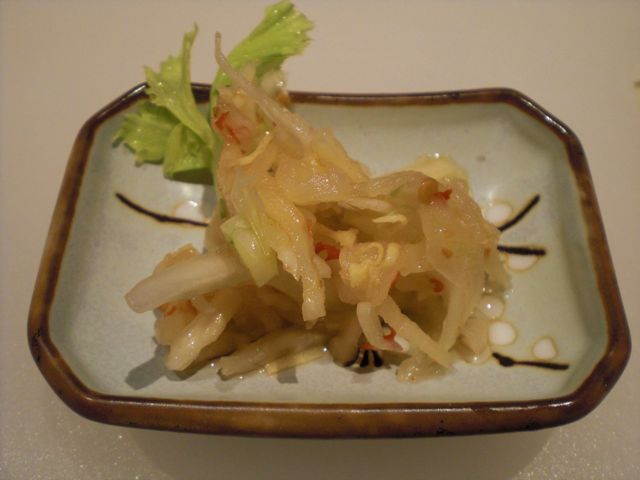Simmered "kiriboshi" daicon 切り干し大根の煮物
After coming to a boil, simmer for 10-15 minutes. For seasoning, I add 3 tbs of mirin and 2-3 tbs of soy sauce (for 200ml of dashi). I add soy sauce in two increments, tasting each time, to adjust the seasoning. Addition of soy sauce just before completing cooking gives fresh soy sauce flavor as well. If you are having this dish with sake, I use less soy sauce and for rice condiments, I use more soy sauce. Simmer for another 10-15 minutes and cut the flame and let it cool in the broth. I garnished with snow peas blanched, shocked in cold water and then julienned.
"Kiriboshi" daikon and celery in vinegar dressing 切り干し大根のハリハリ
This is another classic way of using this ingredients. "Harihari" is a Japanese word to indicate "crunchy". Beside dried daikon, this dish usually calls for julienned cucumber. While I was making this, all the mini-cucumbers I had (although I bought them just few days ago) had brownish discoloration around the seeds and did not taste right (This appears not to be the usual brand I get. It said "seed-less" but it definitely had seeds). So after cutting all 5 cucumbers, I had to discard all of them. Without cucumbers, I rummaged in the refrigerator and found celery.
After re-hydration, I squeezed out the excess water and put the "kiriboshi daikon" in the bowl. I sliced a celery stalk diagonally and thinly. I mixed a small amount of Chinese red pepper paste "Toubanjan" 豆板醤 (1/5 tsp), sushi vinegar (3 parts) and mirin (1 part) and dressed.

After re-hydration, I squeezed out the excess water and put the "kiriboshi daikon" in the bowl. I sliced a celery stalk diagonally and thinly. I mixed a small amount of Chinese red pepper paste "Toubanjan" 豆板醤 (1/5 tsp), sushi vinegar (3 parts) and mirin (1 part) and dressed.
The kiribishi daikon definitely has a crunch as name "harihari" indicates. It is a very simple (especially if you have a cucumber) and refreshing dish. Even with substituting with celery, it was not so bad.

No comments:
Post a Comment